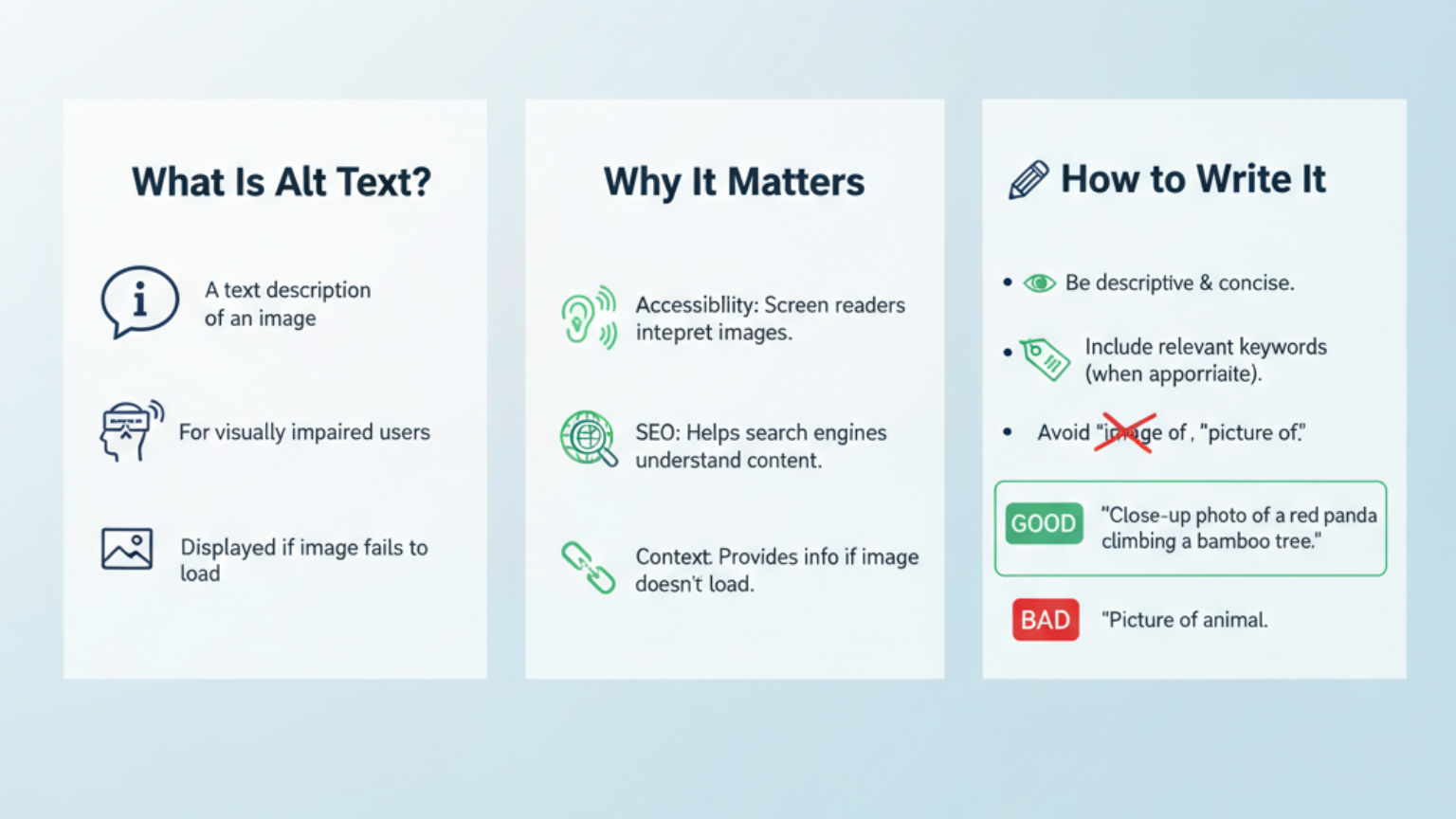In today’s digital world, visuals are everywhere. From product photos and infographics to memes and charts, images help websites connect, communicate, and convert. But what happens when someone can’t see those images? That’s where alt text (also known as alternative text or alt tags) comes in.
If you’ve ever wondered what alt text is, why it’s important, or how to write it effectively — this guide covers everything you need to know.
What Is Alt Text?
Alt text, short for alternative text, is a written description that appears in the HTML code of a webpage to describe an image.
It serves two main purposes:
- To help visually impaired users understand what’s in an image using screen readers.
- To help search engines understand what an image is about for SEO (Search Engine Optimization).
Here’s an example of alt text in HTML:
<img src="golden-retriever-playing-ball.jpg" alt="A golden retriever playing fetch with a tennis ball in a park">
In this example:
- The image file is named
golden-retriever-playing-ball.jpg. - The alt attribute provides a short, descriptive phrase explaining the image.
Even if the image doesn’t load, users and search engines still understand what’s there.
Why Alt Text Matters
Alt text might seem like a small detail, but it plays a huge role in accessibility, SEO, and user experience. Let’s explore each of these benefits in detail.
1. Accessibility: Making the Web Inclusive
The most important purpose of alt text is accessibility.
Millions of people around the world rely on assistive technologies like screen readers — software that reads aloud the content of a webpage, including image descriptions.
When a screen reader encounters an image, it reads out the alt text. Without it, the user might just hear something like “image” or “image123.jpg” — which doesn’t provide any context at all.
Alt text ensures that everyone, regardless of ability, can access and understand the same information.
According to the World Health Organization, over 2.2 billion people worldwide have some form of visual impairment. Adding alt text helps make your website accessible to them.
Accessibility isn’t just a moral choice — it’s also a legal requirement in many regions. For example:
- In the U.S., the Americans with Disabilities Act (ADA) and Section 508 require digital accessibility.
- In the U.K., the Equality Act 2010 applies similar standards.
Failing to include alt text could not only alienate users but also expose your business to legal risks.
<h3 class="wp-block-heading" id="h-2-seo-helping-search-engines-understand-your-images">2. SEO: Helping Search Engines Understand Your ImagesSearch engines like Google can’t “see” images — they rely on text-based descriptions to understand what an image is about.
That’s where alt text becomes valuable for SEO.
When you add descriptive alt text, you’re providing Google with more context about your content. This can:
- Help your images appear in Google Image Search results.
- Improve your overall on-page SEO.
- Make your site more discoverable.
For example, an e-commerce site selling shoes could use alt text like:
alt="Women's white leather sneakers with pink soles"
This helps Google know the image relates to women’s shoes, potentially boosting rankings for relevant keywords.
So alt text isn’t just good for accessibility; it’s good for business too.
3. Better User Experience
Sometimes, images don’t load because of slow internet connections or technical issues.
In those cases, alt text appears in place of the image, helping users understand what was meant to be there.
This improves user experience by:
- Preventing confusion.
- Maintaining context.
- Keeping users engaged, even when visuals fail to load.
It’s a simple way to make your website more resilient and user-friendly.
How to Write Great Alt Text: Best Practices
Now that you know why alt text is important, let’s talk
Don't miss your chance to enroll now.🚀 New Batch Starting Soon!
Here are practical tips and examples to help you get it right every time.
1. Be Descriptive — But Concise
Your goal is to describe the image accurately and clearly in a way that makes sense out of context.
Imagine you’re describing the image to someone over the phone. What details would help them visualize it?
Good example:alt="A chef slicing red bell peppers on a wooden cutting board"
Bad example:alt="Image of food"
oralt="Cutting something"
Be specific — but keep it short. Ideally, under 125 characters, since most screen readers stop reading after that.
2. Don’t Start with “Image of” or “Picture of”
Screen readers already announce that an element is an image, so starting with “Image of” or “Photo of” is redundant.
Good:alt="Two kids building a sandcastle on the beach at sunset"
Bad:alt="Image of two kids building a sandcastle"
Keep it natural — focus on describing the content, not labeling it.
3. Include Context — Not Just Description
Alt text should describe why the image is there, not just what it looks like.
For example, if an image is decorative, it may not need alt text at all.
But if it conveys information, describe its purpose.
Example (context-aware):
On a cooking blog: alt="Step-by-step photo showing how to knead bread dough"
Example (e-commerce):alt="Model wearing a blue floral maxi dress with puff sleeves"
Here, you’re not just describing the image — you’re explaining its relevance.
4. Use Keywords Wisely (But Don’t Stuff Them)
Since alt text helps with SEO, you can include relevant keywords — but only when it makes sense.
Google warns against keyword stuffing in alt text, which can hurt rankings.
Good:alt="Stainless steel water bottle with leak-proof cap"
Bad:alt="Water bottle, stainless steel bottle, leak-proof water bottle, eco-friendly bottle"
Use your target keyword naturally, as part of a meaningful description.
5. Don’t Add Alt Text to Decorative Images
Not every image needs alt text.
If an image is purely decorative — like background textures, icons, or dividers — it doesn’t add meaningful content.
In that case, use empty alt text like this:
<img src="decorative-border.png" alt="">
This tells screen readers to skip the image, so users aren’t distracted by irrelevant details.
6. Use Proper Punctuation and Grammar
Screen readers interpret punctuation literally.
Good punctuation helps the description flow naturally and be easier to understand.
Write in sentence case, use commas to separate ideas, and avoid all caps or excessive punctuation.
Example:alt="Woman smiling while holding a laptop in a coffee shop"
7. Include Text from Images (If Relevant)
If your image contains important text (like on a banner, infographic, or chart), make sure to include that text in the alt description.
Example:alt="Banner showing '50% off all winter coats — this weekend only'"
However, if the text is already present elsewhere on the page (like a caption or heading), you don’t need to repeat it.
Common Mistakes to Avoid
Let’s look at a few alt text mistakes people often make — and how to fix them.
| Mistake | Better Approach |
|---|---|
| Using file names like “IMG_1234.jpg” | Write descriptive alt text |
| Keyword stuffing | Use natural language |
| Adding alt text to decorative images | Leave the alt attribute empty |
| Overly long or detailed descriptions | Keep it under 125 characters |
| Forgetting context | Describe purpose, not just appearance |
Tools to Help You Write and Check Alt Text
You don’t have to do it all manually. There are several tools that can help check or generate alt text:
- Screen Readers (like NVDA, JAWS, or VoiceOver): Test how your alt text sounds.
- WAVE Web Accessibility Tool: Checks missing or poor alt text.
- axe DevTools: Accessibility audit tool for developers.
- Yoast SEO (WordPress plugin): Reminds you to add image alt text.
- Google Lighthouse: Audits accessibility and SEO performance.
Some modern AI tools (like Microsoft’s Accessibility Insights or auto-alt features in CMS platforms) can even suggest alt text, though you should always review it manually for accuracy.
Alt Text vs. Caption vs. Title: What’s the Difference?
It’s easy to confuse these terms, but they serve different purposes:
| Feature | What It Does | Visible to Users? |
|---|---|---|
| Alt Text | Describes the image for accessibility and SEO | No |
| Caption | Provides visible text under an image | Yes |
| Title Attribute | Tooltip text when you hover over an image | Sometimes |
Think of it this way:
- Alt text = for screen readers and search engines.
- Caption = for human readers.
- Title = for additional, optional info.
Real-World Examples of Effective Alt Text
Here are a few examples from different industries to show what great alt text looks like in practice:
E-commercealt="Black leather ankle boots with chunky heels and side zippers"
Travel Blogalt="Snow-covered mountain peaks under a clear blue sky in the Swiss Alps"
Food Blogalt="Freshly baked chocolate chip cookies cooling on a wire rack"
Nonprofit Websitealt="Volunteer handing a box of canned food to a family at a community food drive"
Each one is specific, concise, and adds context.
The Bottom Line: Alt Text Is Small but Powerful
Alt text might seem like a minor detail, but it makes a major difference.
It improves accessibility, enhances SEO, and ensures that your website delivers a meaningful experience for every visitor — with or without images.
When writing alt text, remember the golden rules:
- Be accurate and descriptive.
- Keep it concise.
- Add context when necessary.
- Avoid keyword stuffing.
- Skip decorative images.
It’s one of those small SEO and accessibility tweaks that pay off in a big way — helping your content reach more people, rank higher, and truly be inclusive.
Final Words
Adding proper alt text might seem like an extra step in the content creation process, but it’s one that truly matters. It’s not just about following accessibility laws or pleasing search engines — it’s about being a responsible creator who ensures that every visitor, regardless of ability, can access and understand your content.
Good alt text builds trust, improves search visibility, and strengthens your brand reputation. It reflects your attention to detail and your commitment to inclusivity.
The next time you upload an image to your website or blog, take a few extra seconds to write meaningful alt text. It’s a simple act that makes the digital world a little more open, understandable, and fair for everyone.
Suggestion URL:


